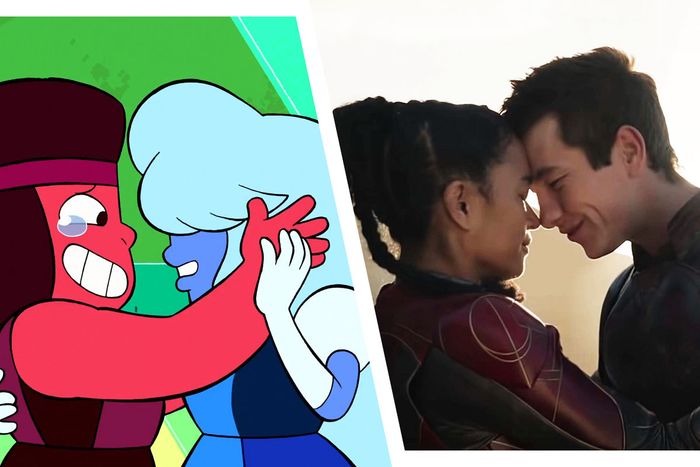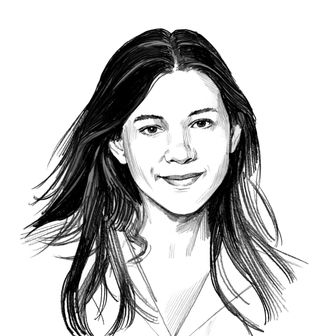
There are a lot of reasons Eternals, Marvel’s most recent phase-launcher now streaming on Disney+, falls short; the brilliant Angelica Jade Bastién has already laid out a number of them. There’s the Richard Madden–shaped charisma hole at its center, the jokes that sink like cement shoes, and oy, more weightless CGI monster fights. But here’s one more indictment against the MCU’s latest: Steven Universe did its plot first, and better.
Spoilers ahead.
Rebecca Sugar’s animated series Steven Universe ran on Cartoon Network from 2013 to 2019, and if you spend a lot of your online life in queer nerd spaces, you probably already know its whole deal. If not, it follows a (half-) human kid named Steven being raised by the Crystal Gems, powerful members of an advanced alien race of immortals who have lived on Earth among its people for around 6,000 years. Some are homesick for their Homeworld, but all of them have grown to love Earth and the imperfect people who inhabit it.
This is more or less the Eternals’ deal, too: They’re a group of superpowerful, immortal emissaries from space, living on Earth among its people for around 7,000 years. Like the Crystal Gems, they’ve occasionally crossed paths with and influenced human development. The Eternals introduced certain technologies like irrigation and the plough. The Crystal Gems’ presence impacted human life so that the show’s universe differs in small but notable ways from ours (the U.S. only has 39 states; the film industry is based in Kansas instead of California). Some characters are homesick: The Eternals’ speedster Makkari stays camped out in their spaceship, dreaming of when they can return to their home planet Olympia, while SU characters Pearl and Peridot fixate on returning to Homeworld. Others, like SU’s Amethyst and Eternals’ Sersi, enjoy the company of humans and the indulgences of human culture.
When Steven Universe begins, the Crystal Gems are unambiguously presented as good guys who spend their days saving Earth from monsters. They battle these monsters with unique weapons that only they can manifest: Garnet can summon giant, powerful fists; Pearl uses a sort of spear; and trickster younger-sister type Amethyst shape-shifts.
When Eternals begins, the Eternals are unambiguously presented as good guys who spend their days saving Earth from monsters. They battle these monsters with unique weapons that only they can manifest: Gilgamesh can summon giant, powerful fists; Thena uses a sort of spear; and trickster younger-sister type Sprite shape-shifts.
I acknowledge that the characters and mythos of the Eternals comics are far older than Steven Universe, and that many of these science-fiction and superhero tropes were established by Marvel and 20th-century American comic books in the first place. But here is where things begin to overlap in a way that doesn’t flatter Eternals by comparison.
We soon learn that the Crystal Gems’ position on Earth is more complicated than the show first let on. For one, the monsters they’ve been fighting are actually Corrupted Gems, and they’re more intelligent than their animalistic forms let on. Turns out, the Gem race was sent to Earth by a small group of massive, powerful space deities called the Diamonds to exploit a lesser planet. The Diamonds planted a massive cluster of fused Gems at the center of the Earth’s core, and this cluster, which has been dormant and incubating for millennia, will soon awaken as one gargantuan being and burst out of the Earth, destroying it.
Thus sums up both the A- and B-plots of Eternals. The action is sparked by the death of the group’s leader, Ajak, much like how Steven Universe begins with the death of the Crystal Gems’ leader, Steven’s mother Rose Quartz. The Eternals believed they were put on Earth to fight monsters called Deviants, but they soon learn that the Deviants are more intelligent and advanced than they used to be. They also learn that the only reason that the massive, powerful space deities called the Celestials (led by the one named Arishem) sent them to fight Deviants was to preserve Earth long enough to incubate a giant, dormant Celestial at the Earth’s core, which will soon awaken and burst out of the Earth, destroying it.
So the Gems/Eternals must defy the will of the Diamonds/Arishem and stop the Cluster/Celestial at the Earth’s core from awakening and busting the planet to bits. Both situations seem hopeless, but Steven Universe’s Steven and Eternals’ Druig both use an amplified psychic power to reach and subdue the sentient threat in the center of the Earth.
Where the two stories differ is in what themes these extremely similar plots are used to explore. When the Eternals learn that they’re essentially space robots who cannot evolve, it’s bittersweet, but only within the framework of the film’s Randian obsession with themes of evolution and progress. Director Chloé Zhao told Variety that she intended for Eternals to be infused with a Taoist philosophy similar to Steven Universe’s, saying, “In our society, in the stories we tell about ourselves, we often emphasize and celebrate masculine strength — the strength of constant action, of winning, of innovating and expending. In Eternals, we wanted to explore the feminine strength in all of us — the strength that comes from vulnerability, love, forgiveness and ‘actionless action.’” These are beautiful ideas that are not reflected in the film’s chilly, bird’s-eye view of humanity. It only zooms in on actual people at moments of productivity and industriousness: the agrarian economy, the efficient film set, the American suburban home.
Meanwhile, when the Crystal Gems marvel at humans’ un-Gem-like ability to grow and change, it’s more about the freedom to err, learn, accept each other, love each other, and live as one’s honest identity. In Steven Universe, when two gems fuse, it’s an act of trust and love that is stigmatized and forbidden on their home planet. In this way, fusion is queer-coded, and this fantastical device is used to introduce nonbinary characters like Stevonnie and gay relationships like Ruby and Sapphire, whose existence is central to the show’s plot and worldview. And because fusion is introduced to the viewer as such an intimate and meaningful act, the Cluster is terrifying not only because it threatens to destroy the Earth, but because it was made by force, without its composite gems’ consent. Eternals’ Celestials, meanwhile, are just an inversion of Marvel’s stale old Act Three threat of “giant hole in the sky.” A generous reading could cast the final rift between Sersi and Ikaris as a pro-choice allegory, with the unsympathetic zealot Ikaris bullishly insisting that it’s worth carrying the Celestial to term and destroying the beings of Earth without their consent because it will create potential, future life. But that’s, like, a galaxy-brain stretch; it takes some squinting.
And while the cast of Eternals is admirably diverse, that diversity has been used as a shield by MCU fans against genuine criticisms of the film. Brian Tyree Henry’s character Phastos gives a small, impassioned speech toward the end of the movie about how he cherishes his son and his husband, and how he lives for himself and not for any Celestial. But the kiss he shares with his husband earlier in the movie is the sort of thing that a homophobic censor could cut out, with the rest of the film remaining largely identical. In fact, this has already happened in certain film markets. Queerness, identity, and diversity of bodies in Eternals are not as thematically, explicitly crucial to the plot as they are in Steven Universe. The Gems of Steven Universe all fight for Earth because it’s a place where they can make chosen families, find euphoria in the fullest expression of their identities, and dance and transform and kiss whomever they want. It’s what makes us care about all of these characters, not just one out of ten. If Marvel had the courage of its convictions, Eternals could have been something special. Steven Universe is a taste of what it could have been.
Also, Steven Universe has more interesting color palettes than just “all golden hour always,” and the jokes actually land. So.
More on The Eternals
- Eternals’ Hottest Romance Made Me Feel Pleasantly Unwell
- Who Is Eros, Marvel’s New Star Playboy?
- Nine Easter Eggs You Might Have Missed in Eternals


